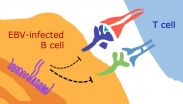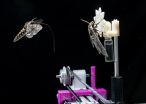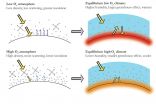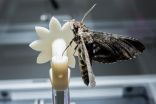(Press-News.org) DARIEN, Ill. -- A new study suggests that bright light at the end of a night shift may have potential as a countermeasure to improve driving performance, particularly for low light work environments and commutes that occur before dawn.
Results show that temperature, subjective alertness and psychomotor vigilance performance decreased significantly across the night. Bright light significantly suppressed melatonin, but did not improve subjective alertness or psychomotor vigilance performance. Sleep deprivation markedly increased incidents, accidents, and the average lane position. These measures worsened with time on task. Bright light compared to dim light did not improve performance during the first 22 minute circuit, but across the two circuits bright light significantly attenuated the effect of time on task on incidents and accidents.
'We were most surprised to find that significant differences between the bright light condition and the dim light condition occurred in the second lap of the simulated driving task rather than immediately following the bright light exposure,' said study lead author Denise Weisgerber, a doctoral candidate at Simon Fraser University in Burnaby, British Columbia, Canada. 'The immediate effects of bright light exposure may have been masked by the increased arousal associated with being placed in the driving simulator.'
The research abstract was published recently in an online supplement of the journal Sleep and was presented on June 9 in Seattle, Wash., at SLEEP 2015, the 29th annual meeting of the Associated Professional Sleep Societies LLC.
The study group comprised 19 participants who were prescreened for chronotype, sleep disorders and motion sickness in the driving simulator. The majority were male, with a mean age of 23. A repeated measures, cross-over balanced design was used, with no less than one week between the following three conditions: no sleep deprivation, overnight sleep deprivation with 45 minutes of dim light exposure and overnight sleep deprivation with 45 minutes of bright light exposure. Subjects then received the light treatment, followed by a 45 minute driving test in a high-fidelity simulator.
INFORMATION:
The study was supported with funding from the Natural Sciences and Engineering Research Council (Canada).
Abstract Title: Driving Home from the Night Shift: A Bright Light Intervention Study
Abstract ID: 0365
Presentation Date: Tuesday, June 9
Presentation Type: Poster 74
Presentation Time: 4 p.m. to 6 p.m.
The SLEEP 2015 abstract supplement is available at http://journalsleep.org/ViewAbstractSupplement.aspx.
For a copy of the abstract or to arrange an interview with the study author or an AASM spokesperson, please contact:
Lynn Celmer
lcelmer@aasmnet.org
630-737-9700, ext. 9364
AASM
About SLEEP 2015
More than 5,000 sleep medicine physicians and sleep scientists will gather at SLEEP 2015, the 29th annual meeting of the Associated Professional Sleep Societies LLC (APSS), which will be held June 6-10 at the Washington State Convention Center in Seattle. The scientific program will include about 1,200 research abstract presentations. The APSS is a joint venture of the American Academy of Sleep Medicine and the Sleep Research Society (http://www.sleepmeeting.org).
About the American Academy of Sleep Medicine
Established in 1975, the American Academy of Sleep Medicine (AASM) improves sleep health and promotes high quality patient centered care through advocacy, education, strategic research, and practice standards. With nearly 10,000 members, the AASM is the largest professional membership society for physicians, scientists and other health care providers dedicated to sleep medicine (http://www.aasmnet.org).
LEXINGTON, Ky., June 12 -- In a new University of Kentucky study published today in Cell Reports, a leading scientific journal in cell biology, researchers describe a new molecular mechanism that contributes to age-related macular degeneration (AMD) due to accumulation of excessive iron within the cells of the retina.
Cells of the body use iron in dozens of normal metabolic processes. However, excessive iron or 'iron overload' can be very damaging to cells and tissues, and is implicated in numerous diseases, including AMD.
'The reason that cells die due to iron ...
About 90% of adults worldwide are infected with Epstein-Barr virus, or EBV. The virus infects B cells (the white blood cells that make antibodies) and can contribute to B-cell-derived cancers, but in most people it remains dormant--a state scientists refer to as "latent infection"--for the rest of their lives. A study published on June 11th in PLOS Pathogens sheds new light on why the infected person's immune system cannot eliminate EBV, or the associated cancer risk.
Interested in the immune response against EBV, Andreas Moosmann, from the Helmholtz-Zentrum in Munich, ...
It's difficult enough to see things in the dark, but what if you also had to hover in mid-air while tracking a flower moving in the wind? That's the challenge the hummingbird-sized hawkmoth (Manduca sexta) must overcome while feeding on the nectar of its favorite flowers.
Using high-speed infrared cameras and 3-D-printed robotic flowers, scientists have now learned how this insect juggles these complex sensing and control challenges - all while adjusting to changing light conditions. The work shows that the creatures can slow their brains to improve vision under low-light ...
ANN ARBOR--Variations in the amount of oxygen in Earth's atmosphere significantly altered global climate throughout the planet's history. Efforts to reconstruct past climates must include this previously overlooked factor, a new University of Michigan-led study concludes.
Oxygen currently comprises about 21 percent of Earth's atmosphere by volume but has varied between 10 percent and 35 percent over the past 541 million years.
In periods when oxygen levels declined, the resulting drop in atmospheric density led to increased surface evaporation, which in turn led to ...
This news release is available in Japanese.
Water injected into an inactive fault can cause aseismic slip along the fault -- movement without detectable earthquakes -- that may then indirectly lead to micro-earthquakes. That's the result from a controlled experiment by Yves Guglielmi and colleagues, who observed these events in real time after injecting fluid into a natural fault near an underground experimental facility in southeastern France. Researchers are intensely interested in this type of induced seismicity, especially with a rise in earthquakes caused by ...
This news release is available in Japanese. New experiments in the Japanese rice fish show that the fox13 gene appears to be the switch that determines whether a germ cell becomes an egg or sperm cell. The finding could help researchers learn more about how the sexual fate of germ cells is determined during vertebrate development. Toshiya Nishimura and colleagues demonstrated that fox13, which is expressed in germ cells but not in the surrounding cells of the fish's reproductive organs, provides a molecular cue that prevents the start of sperm formation. When the researchers ...
This news release is available in Japanese.
Variations in the percentage of atmospheric oxygen may have influenced climate in the past 500 million years, according to new calculations by Christopher Poulsen and colleagues. Since oxygen isn't a greenhouse gas like carbon dioxide, it typically hasn't been included in studies of past climate change. But the proportion of atmospheric oxygen has varied between 10 percent and 35 percent over the past 500 million years, and Poulsen and colleagues have developed a model to show how those fluctuations might impact climate. ...
This news release is available in Japanese.
How do nocturnal insects forage so successfully in the twilight and darkness? A new study by Simon Sponberg and colleagues suggests that the vision of the hawkmoth, Manduca sexta, which hovers in place while it feeds on nectar at dawn and dusk, is finely attuned to the swaying of flowers in the breeze. These findings imply that both the sight and flight of the hawkmoth likely evolved to match the movements of flowers -- their only source of food -- perfectly, helping to explain how the nimble insects are able ...
A new study by researchers at the Stanford University School of Medicine found that synchronized physiological interactions between remote brain regions have genetic underpinnings.
The research was performed at Stanford but was made possible by collaborations with the Seattle-based Allen Institute for Brain Science and the IMAGEN Consortium, a multicenter European project, said the study's senior author, Michael Greicius, M.D., an associate professor of neurology and neurological sciences.
The study will be published June 11 in Science.
An emerging consensus among ...
This news release is available in German.
It has been hypothesized that globalization of human-mediated dispersal of species may break down biogeographic boundaries. However, empirical tests had been lacking until recently. An international research team has now discovered a comprehensive biogeographic reorganization for 175 species of alien gastropods across 56 countries. The data shows that homogenization is indeed happening. Geographic barriers to dispersal have fallen down but climate still limits how species colonize new areas. The study was published in the ...



